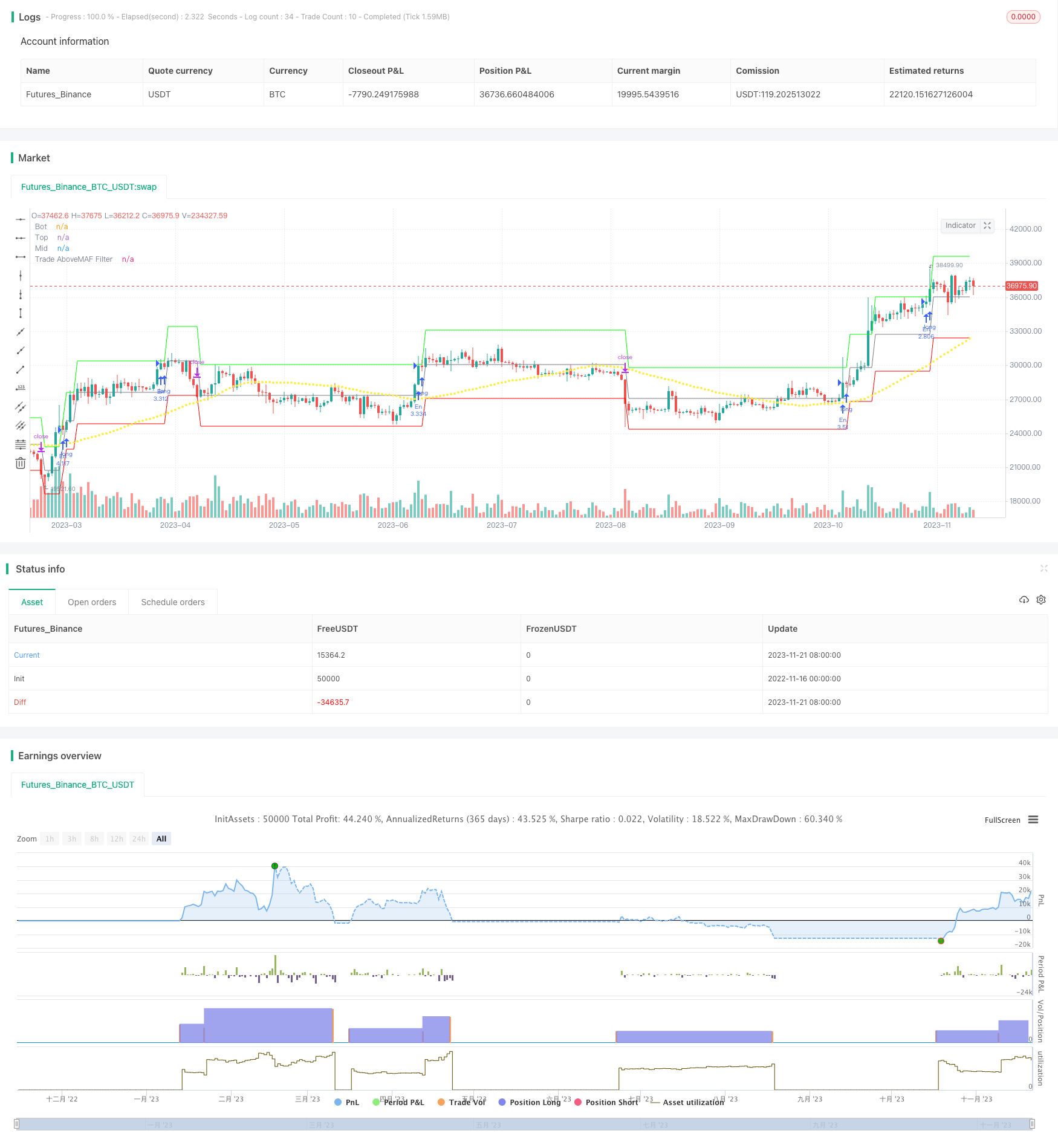The Dynamic Box Percentage Tracking Strategy
Author: ChaoZhang, Date: 2023-11-23 10:32:39Tags:

Overview
This strategy uses percentage price changes to set entry lines and stop loss lines. It enters positions when prices break through the entry line and exits positions when prices fall below the stop loss line. Its main feature is that it only takes on one unit of risk, meaning that new positions will only be added after the previous position reaches a preset profit target.
Principles
The strategy first sets a benchmark price and uses 10% of that price as the price range - the upper bound is the entry line and the lower bound is the stop loss line. When prices break through the entry line, fixed quantities will be bought. When prices fall below the stop loss line, positions will be closed out. After making profits, the entry and stop loss lines will be adjusted by percentage to expand the profit range. This allows the strategy to track trend runs.
Another key point of the strategy is that it only takes on one unit of risk. That is, new positions will only be added after the current position reaches the profit target. The new positions will also follow the new entry and stop loss lines. This limits risk.
Advantage Analysis
This strategy combines the advantages of trailing stops and position sizing, allowing for effective risk control while being profitable.
- Using percentage ranges for entry and stop loss lines allows automatic trend tracking
- Risk is limited to single digits, avoiding major losses
- New positions are only added after profits, avoiding chasing trends
- Stop loss lines move up after profits, locking in gains
Risk Analysis
There are also some risks:
- If percentage ranges are too wide, risk may expand
- If ranges are too narrow, profit potential is limited
- Improper stop loss placement may lead to premature exiting
- Aggressive additions may amplify losses
These risks can be avoided by adjusting parameters like range sizes, entry filters etc.
Optimization
There is room for further optimization:
- Combining with trend indicators to determine trend direction
- Adding machine learning models for more adaptive lines
- Testing different addition conditions to lower risk
- Finding optimal holding periods through testing
Conclusion
This is a simple and practical percentage range-based system. Through parameter tuning and model optimization, this strategy can become a reliable trend tracking tool, generating stable outperformance for investors.
/*backtest
start: 2022-11-16 00:00:00
end: 2023-11-22 00:00:00
period: 1d
basePeriod: 1h
exchanges: [{"eid":"Futures_Binance","currency":"BTC_USDT"}]
*/
//@version=4
// This source code is subject to the terms of the Mozilla Public License 2.0 at https://mozilla.org/MPL/2.0/
// © HermanBrummer 4 April 2021
strategy ("The Box Percent Strat", shorttitle="The Box", overlay = true)
/// Designed for LONG only on Daily, 2D or 3D Charts
/// Uses fixed investment risk amount, meaning you're willing to lose that amount per trade
/// Limit buy to not overpay
RiskPerTrade = input(10000, "Risk losing this much per trade", tooltip="This calculates how much you will lose based on difference between the entry price and stop loss price")
TradeAboveMAFilterPer = input(50, "The System won't trade if price is below this MA")
UpBoxSize = (input(10, "Box size in %") * 0.01)+1 // 1.1 == 10% up
DnBoxSize = 1-(input(10, "Box size in %") * 0.01) // 0.9 == 10% dn
var FirstBar = close > 0 ? close : na
var FirstTop = FirstBar * UpBoxSize
var FirstBot = FirstBar * DnBoxSize
var top = sma(FirstTop, 1)
var bot = sma(FirstBot, 1)
/// The Box Calcs
if high[2] > top
top := top * UpBoxSize
bot := bot * UpBoxSize
if low[1] < bot
top := top * DnBoxSize
bot := bot * DnBoxSize
plot(bot, "Bot", #ff0000) // Green
plot(top, "Top", #00ff00) // Red
mid = ((top-bot)/2)+bot
plot(mid, "Mid", color.gray)
TradeAboveMAFilter = sma(close, TradeAboveMAFilterPer)
plot(TradeAboveMAFilter, "Trade AboveMAF Filter", color.yellow, 3, style=plot.style_circles)
// col = high[1] < top and high >= top ? color.white : na
// bgcolor(col)
/// Shares
RiskRange = close * abs(DnBoxSize - 1) // 0.9 - 1 == 1.10 // 10% abs so you don't get a neg number NB NB
Shares = RiskPerTrade / RiskRange
//plot(close-RiskRange, "RiskRange", color.fuchsia)
Enter = high >= top
and close[1] > TradeAboveMAFilter
and strategy.opentrades[0] == strategy.opentrades[1]
and strategy.opentrades[1] == strategy.opentrades[2]
and strategy.opentrades[2] == strategy.opentrades[3]
and strategy.opentrades[3] == strategy.opentrades[4]
and strategy.opentrades[4] == strategy.opentrades[5]
and strategy.opentrades[5] == strategy.opentrades[6]
// won't enter if new positon was taken in the last 6 bars
// need better code for this.
/// Buy & Sell
// (new highs) and (Close above moving average filter) and (No new trades were taken receently)
if Enter //(high >= top) and (close[1] > TradeAboveMAFilter) and strategy.opentrades[0] == strategy.opentrades[1]
strategy.order("En", strategy.long, qty=Shares, limit=top)//, stop=top)
//barcolor(strategy.position_size != 0 ? #00ff00 : color.gray)
// /// If ONE Position THEN this Stop Because:
// if strategy.position_size == 1
// strategy.exit("Ex", "En", stop=bot)
/// If it has more than one trad OPEN
if strategy.position_size > 0
strategy.exit("Ex", "En", stop=bot[2] ) // puts stop on old bot
//plot(strategy.position_avg_price, "Avg Price", color.yellow)
- Momentum Turtle Trend Tracking Strategy
- Bearish Harami Reversal Backtest Strategy
- Dynamic Moving Average Strategy
- Momentum Alpha Strategy
- Double VWAP Oscillation Breakthrough Strategy
- Low-High-Trend Strategy
- Cloud Soaring High Yield Daily Trading Strategy
- Bollinger Trend Shock Trading Strategy
- Dynamic Price Swing Oscillator Strategy
- Dual Rate of Change Momentum Indicator Trading Strategy
- SSL Channel Backtester Strategy With ATR and Money Management
- Bollinger Band Reversal Based Quantitative Strategy
- Dual Reversal Tracking Strategy
- Modern Laguerre Transform Relative Strength Index Optimization Strategy
- Dual Moving Average Crossover Trend Strategy
- Bollinger Band Trend Chaser
- Moving Average Crossover Strategy
- Kairou Strategy
- Trend Following Strategy Based on Stochastic and CCI
- DPD-RSI-BB Quantitative Strategy